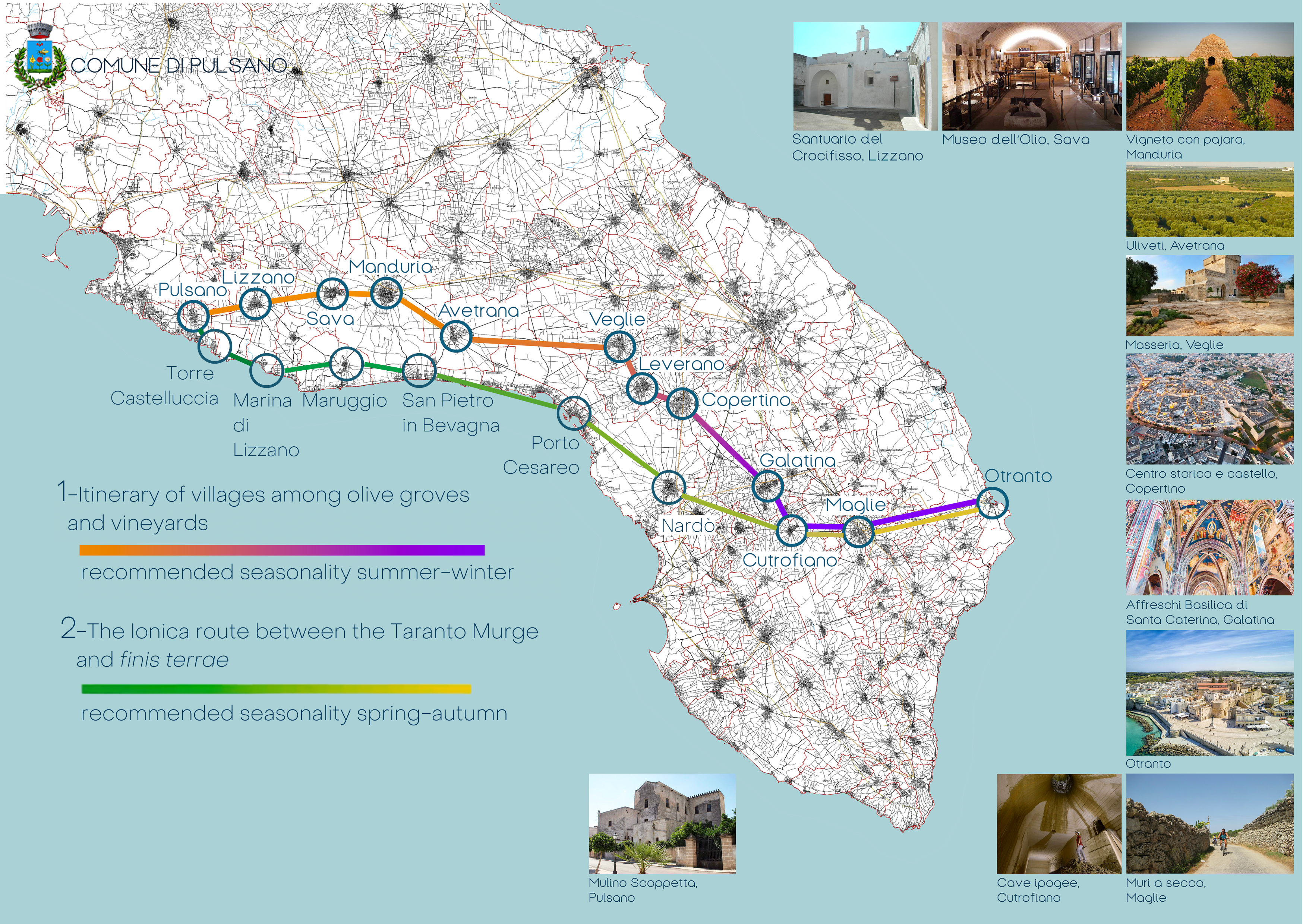Sustainability, identity and enhancement of cultural heritage are just some of the key concepts underlying the cultural paths created thanks to the AI SMART project. The two paths identified will favor the interaction of the port of Otranto with the inland territories and the opposite Ionian coast, in order to promote sustainable and inclusive transnational tourism in the Apulian territory.
The tourist heritage, the accommodation offer and the services for tourists, as well as the modes of transport that connect the stages of each of the two itineraries, have been the subject of careful mapping and analysis, the results of which have been used to implement the pages of the AI SMART digital platform: https://interregaismart.regione.puglia.it/
The first path, called “Itinerary of villages among olive groves and vineyards“, winds between the provinces of Taranto and Lecce and identifies the territory of Pulsano as the starting point and then continues in the municipalities of Lizzano, Sava, Manduria, Avetrana, Veglie, Leverano, Copertino, Galatina, Maglie and ends in the territory of Otranto. There are numerous cultural, historical and naturalistic assets to visit and which characterize these places. Among these are the Scoppetta Mill, one of the stages of the pilgrims’ path that hosts numerous sacred and religious events, located in the territory of Pulsano, the Civic Museum of Paleontology of Lizzano with its rich collection of archaeological finds and historical evidence, the Grava Palombara, an ancient cave used as a place of worship located in Sava, the vineyards of Manduria and the Natural Reserve of the mouth of the River Chidro, the Caves of Villanova and the underground oil mills of the municipality of Avetrana, the historic center of Maruggio and its numerous historical monuments and ancient churches.

The route continues in the territory of Veglie and Leverano, with its characteristic flower market, and then reaches Copertino whose famous castle, which gives its name to the square that hosts it and represents a significant example of Renaissance military architecture in Puglia. Also noteworthy are the numerous palaces and the Tartaro theater in Galatina, the underground caves and crypts of Cutrofiano, Villa Tamborrino and the underground oil mill located in the countryside of Maglie. The route ends in Otranto, the arrival point of the two itineraries, with its magnificent Baia dei Turchi, the Alimini Lakes and the Aragonese Castle.
The second path, instead, is called “The Ionica route between the Taranto Murge and finis terrae” and it starts from the Ionian coast, crossing the hinterland, and ends in the territory of Otranto. A long path that enhances and promotes the cultural, historical and environmental resources that the territory conserves. The first stop on the route is Torre Castelluccia, an asset recognized by the FAI – Fondo per l’Ambiente Italiano and located in the Pulsano marina, followed by the Lizzano marina where it is possible to admire the suggestive beaches, characterized by a rich biodiversity. The route reaches Maruggio where there are numerous coastal towers, including Torre dell’Ovo and Torre Moline, built in past centuries to defend the town from attacks by the Saracens. Of great cultural and historical interest, also the locality of San Pietro in Bevagna, famous for its high-quality primitive wine and for the numerous landscape and architectural assets, such as the Natural Reserve of the mouth of the River Chidro, whose river is fed from various karst slopes. The route leaves the province of Taranto behind to reach the province of Lecce where Porto Cesareo and Nardò are located, with their numerous coastal towers and ancient caves, but also with their regional parks and natural reserves. Proceeding towards the hinterland, the route crosses the localities of Cutrofiano and Maglie with its historic Dolmens and Menhirs, and then ends in Otranto, which is characterized by its numerous civil and religious architectures and for its environmental and naturalistic assets.